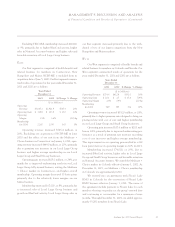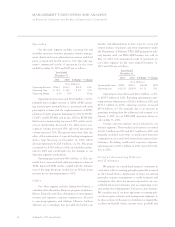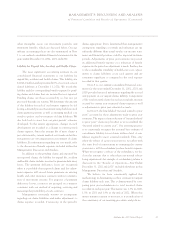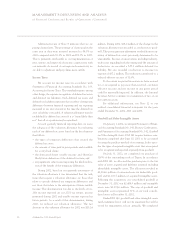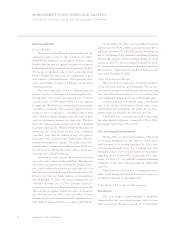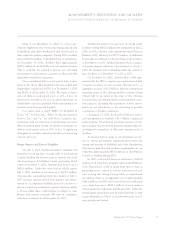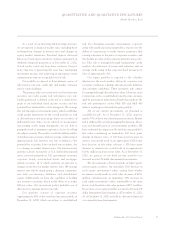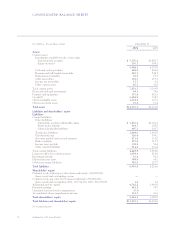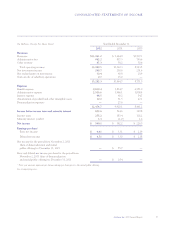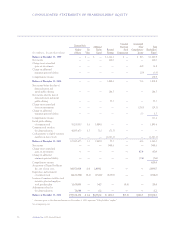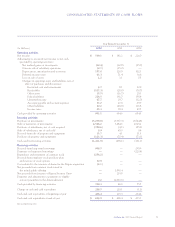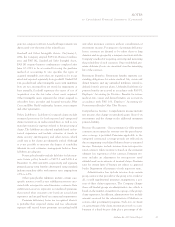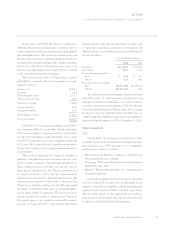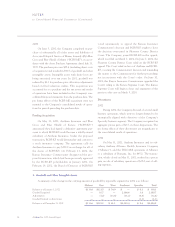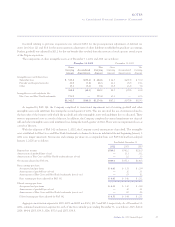Anthem Blue Cross 2002 Annual Report Download - page 60
Download and view the complete annual report
Please find page 60 of the 2002 Anthem Blue Cross annual report below. You can navigate through the pages in the report by either clicking on the pages listed below, or by using the keyword search tool below to find specific information within the annual report.
QUANTITATIVE AND QUALITATIVE DISCLOSURES
About Market Risk
Anthem, Inc. 2002 Annual Report 55
As a result of our investing and borrowing activities,
we are exposed to financial market risks, including those
resulting from changes in interest rates and changes in
equity market valuations. Potential impacts discussed
below are based upon sensitivity analyses performed on
Anthem’s financial positions as of December 31, 2002.
Actual results could vary from these estimates. Our pri-
mary objective is preserving the asset base, maximizing
investment income, and achieving an appropriate return
commensurate with an acceptable level of risk.
Our portfolio is exposed to three primary sources of
risk: interest rate risk, credit risk, and market valuation
risk for equity holdings.
The primary risks associated with our fixed maturity
securities are credit quality risk and interest rate risk.
Credit quality risk is defined as the risk of a credit down-
grade to an individual fixed income security and the
potential loss attributable to that downgrade. We manage
this risk through our investment policy, which establishes
credit quality limitations on the overall portfolio as well
as diversification and percentage limits on securities of
individual issuers. Since we are advised of circumstances
surrounding credit rating downgrades, we are able to
promptly avoid or minimize exposure to losses by selling
the subject security. The result is a well-diversified portfolio
of fixed income securities, with an average credit rating of
approximately AA. Interest rate risk is defined as the
potential for economic losses on fixed rate securities, due
to a change in market interest rates. Our fixed maturity
portfolio consists exclusively of U.S. dollar-denominated
assets, invested primarily in U.S. government securities,
corporate bonds, asset-backed bonds and mortgage-
related securities, all of which represent an exposure to
changes in the level of market interest rates. We manage
interest rate risk by maintaining a duration commensu-
rate with our insurance liabilities and shareholders’
equity. Additionally, we have the capability of holding
any security to maturity, which would allow us to realize
full par value. Our investment policy prohibits use of
derivatives to manage interest rate risk.
Our portfolio consists of corporate securities
(approximately 40% of the total fixed income portfolio at
December 31, 2002) which are subject to credit/default
risk. In a declining economic environment, corporate
yields will usually increase prompted by concern over the
ability of corporations to make interest payments, thus
causing a decrease in the price of corporate securities, and
the decline in value of the corporate fixed income portfo-
lio. This risk is managed through fundamental credit
analysis, diversification of issuers and industries and an
average credit rating of the corporate fixed income port-
folio of approximately AA.
Our equity portfolio is exposed to the volatility
inherent in the stock market, driven by concerns over
economic conditions, earnings and sales growth, inflation,
and consumer confidence. These systematic risks cannot
be managed through diversification alone. However, more
routine risks, such as stock/industry specific risks, are man-
aged by investing in index mutual funds that replicate the
risk and performance of the S&P 500 and S&P 400
indices, resulting in a diversified equity portfolio.
All of our current investments are classified as
available-for-sale. As of December 31, 2002, approxi-
mately 97% of these were fixed maturity securities. Market
risk is addressed by actively managing the duration, alloca-
tion and diversification of our investment portfolio. We
have evaluated the impact on the fixed income portfolio’s
fair value considering an immediate 100 basis point
change in interest rates. A 100 basis point increase in
interest rates would result in an approximate $178.6 mil-
lion decrease in fair value, whereas a 100 basis point
decrease in interest rates would result in an approximate
$214.2 million increase in fair value. As of December 31,
2002, no portion of our fixed income portfolio was
invested in non-US dollar denominated investments.
We also maintain a diverse portfolio of large capital-
ization equity securities. An immediate 10% decrease in
each equity investment’s value, arising from market
movement, would result in a fair value decrease of $15.1
million. Alternatively, an immediate 10% increase in
each equity investment’s value, attributable to the same
factor, would result in a fair value increase of $15.1 million.
No portion of our equity portfolio was invested in non-US
dollar denominated investments as of December 31, 2002.
As of December 31, 2002, we held no derivative financial
or commodity-based instruments.


